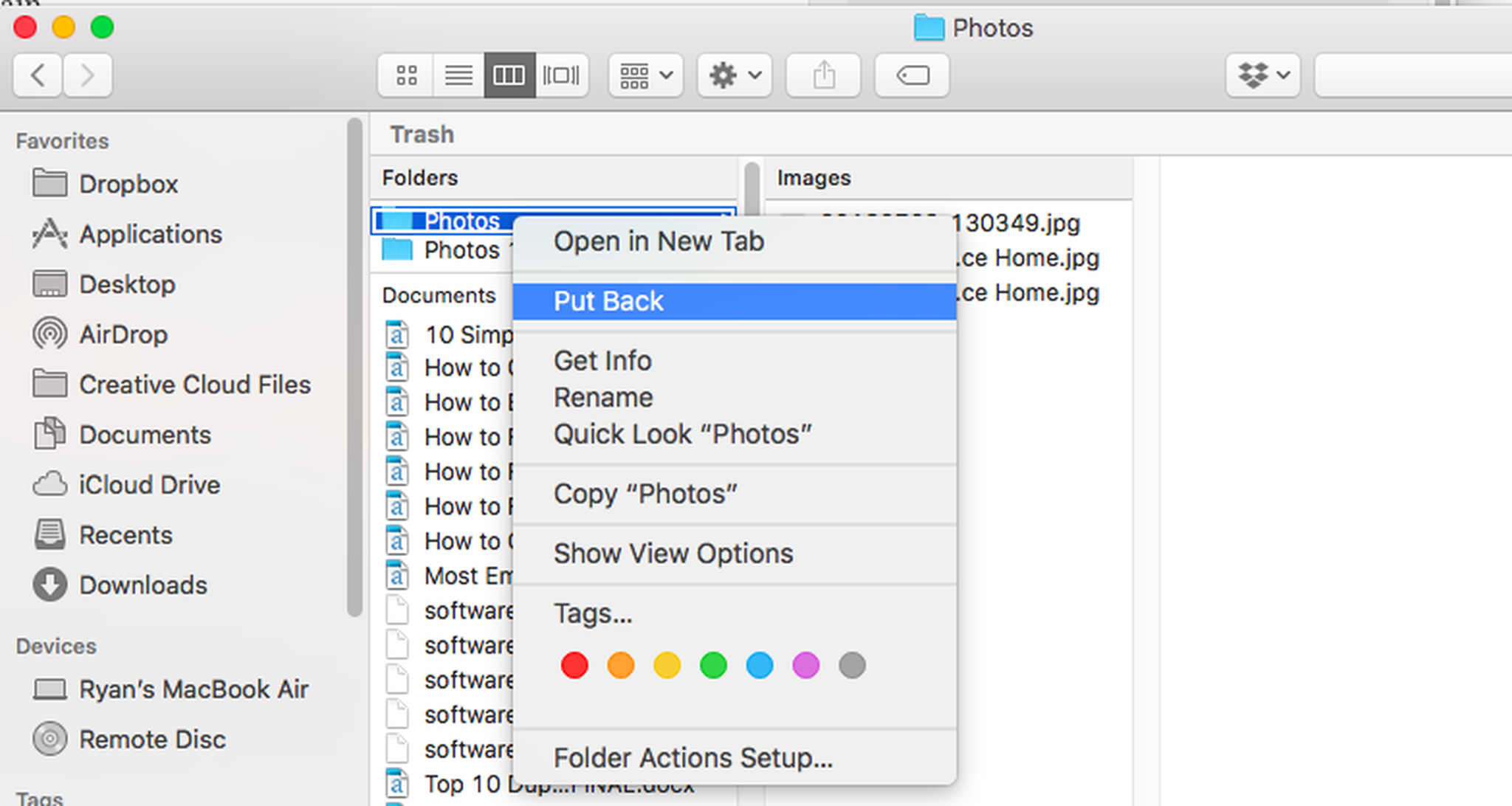Get a data lifeguard for Mac
Press Control + Click on the Trash icon to open. Highlight all the files inside the Trash folder. Drag all the files into the terminal window and press Enter. Provide the administrator password and hit Enter. Wait until the process is completed. It might take a while for the terminal to complete the action. The steps to perform macOS empty Trash recovery are as follows: Step 1: Install and launch. Stellar Data Recovery Free Edition software in your MacBook, Mac mini, or iMac. Step 2: From the “ Select What To Recover ” screen, select the type of files that you want to recover, then click Next. Step 3: From the “ Select Location ” screen.
Are you sure you want to delete “THIS REALLY IMPORTANT FILE”?
*Hits Delete*
Wait! I mean Cancel. I meant to press Cancel. I NEED THAT FILE.
Noooooo!
We’ve all been there. Inexplicably deleting a file and regretting it immediately. It sucks. It really does. But it’s not the end of the world. There are ways and means of recovering your files. More specifically, there are tools, tips, and tricks to help you recover your files.
Best File Recovery Apps for Mac
Recover deleted files with Setapp. So that nothing ever gets lost in the shuffle.

In this article, we’ll discuss how to recover deleted files on Mac with the help of an extensive selection of solutions. They will be suitable for a variety of different scenarios that you might find yourself in when trying to recover lost or missing data.
Let’s dig in.
Common reasons leading to lost data
Besides the human error — an example we’ve started this article with, — there are other reasons for having lost files and data on your laptop. Some of the most widespread are software corruption or critical errors, malware, and hardware failure.
While hardware failure can mean your data is unrecoverable, other types of data loss can often be reversed with various Mac files recovery techniques.
Is it possible to recover deleted files?
If you are wondering if it’s possible to retrieve a deleted file on your Mac after you’ve mistakenly removed it or there’s been a software malfunction, don’t worry, it likely is. One of our favorite solutions for undeleting files on Mac is dedicated file recovery app Disk Drill (which we will go on in detail about later in the article), but there are other ways which we shall discuss first, so read on.
The best ways to recover deleted files on Mac
From restoring deleted files from your Mac’s Trash to recovering a completely deleted file, let’s look at some of the best ways to address the recovery of your deleted files.
Check the Trash bin
This might be an obvious one, but just to be sure you didn’t miss anything, click on the Trash icon in your Dock and go through the files there. If you spot the file you need, just double-finger click on it and select Put Back menu option to restore your file:
Retrieve deleted files with Undo command
If you’ve just deleted your file and haven’t performed any other actions on your Mac, here’s how to recover this file from Trash on Mac almost instantly.
Without exiting the folder, press Command + Z hot key combination to see your file return immediately to the folder.

That’s it, just like magic.
Recover deleted files with Disk Drill
Disk Drill is a popular solution among Macintosh users to recover deleted files. The app can help find files you’ve deleted from your Trash or that were lost in a software glitch.
To see all the files that can be restored, install the app and run the Disk Drill scan on your Mac:
Browse the results or search for exact file name or extension:
Select the files you want back and click the blue Recover button at the bottom right. Select where to put your file and you are done.
Recover files from backups on a Mac
To be absolutely sure all your data is secure, your best bet is creating a backup. You can use the built-in Time Machine option or third-party solutions like Get Backup Pro or ChronoSync Express.
All of them have their strengths and weaknesses, so let’s take a closer look and see what fits best with your style of file management and the type and size of data you work with.
To create a backup with Time Machine, open the Apple menu, go to System Preferences, and find Time Machine:
Next, connect a hard drive to create a Time Machine backup and select the files folders you want backed up. You can either back up your full machine (this takes more time and requires more space on your drive) or exclude some of the files and folders to only focus on the items you really need.
After your backup is done, you can go back to that version of your machine any time you want and select the files you’ve lost or accidentally deleted.
To do that, open Finder > Applications and double-click on Time Machine.
You’ll see a set of windows, one after the other. Click on the arrows to the right of the window stack to navigate your Time Machine versions. Once you find the correct time of the backup, browse through folders to locate your missing file:
Click Restore to put it back where it originally was. The Restore button will be greyed out for the files that haven’t been deleted and don’t need restoring. And yes, this method will help you recover emptied Trash on your Mac — if the file you deleted was saved in an existing Time Machine snapshot.
Alternatively, you can use apps to create backups and sync files with more flexibility and customization.
Get Backup Pro is one such solution. The app allows you to set up backup tasks for various projects, create a backup schedule, and customize multiple elements of the process.
Once you set up your preferences, drag and drop the items you want backed up onto the backup project you’ve customized and click the blue play button to do the initial backup.
ChronoSync Express is a stellar synchronization option if you want to avoid multiple versions of the same files and folders.
With the app, you can sync folders, create backups, and schedule tasks:
As you can see, these apps are excellent for a targeted approach with detailed backup management and syncing individual folders at the exact time you require it.
Is it possible to restore files via Terminal?
If you did a quick search for ways to recover deleted files on your macOS, you might’ve seen guides on recovering files placed in Trash with the help of Terminal.
The step-by-step tutorials suggest to open the app (Finder > Applications > Utilities > Terminal) and type in cd. Trash command. Next, to see the files in Trash, the command ls is entered. Finally, to move the file out of Trash to home directory, mv
It mainly focuses on partition recovery. It enables users to find deleted or lost partitions by fixing the partition tables due to software crash, virus attack, mistaken formatting, etc.
Highlighted Features:
# 1. Partition Recovery
When a partition lost or disappeared on Mac due to corrupted partition tables, Mac users can apply TestDisk to rebuild and repair the corrupted partition table.
# 2. Rebuild Boot Sectors
When the Mac bootable drive fails to boot, it corrects problems in bootable drives that are failing to boot.
Pros:
- Completely free and open.
- Runs on several operating systems, including macOS and Mac OS X versions.
- Recover lost partitions and rebuild the partition table.
Cons:
- Use the command line to make data recovery.
- Not user-friendly for regular computer users.
5. Exif Untrasher
Exif Untrasher is another completely free Mac data recovery tool that mainly restores deleted or JPEG files from digital cameras, external drive, USB stick, SD card, etc. You can easily download and install this software on your Mac running Mac OS X 10.10 and all the later versions.
Highlighted Features:
# 1. Highly Efficient in JEPG Recovery
Exif Untrasher is a tool that mainly designed to locate photos in JEPG formats on any kind of storage device like SD card, CF card, memory stick or Mac hard disk.
External storage device needs to be mounted as a volume on Mac for the utility to access and attempt a restore.
Pros:
- Simple and quick to recover lost images from the memory card.
- Free with no quantity limits.
- It is updated by the developer regularly.
Cons:
- It only works for JEGP file recovery. It doesn't support extra file formats.
3-Step Tutorial of Free Mac Data Recovery
To help more Mac users to bring their lost files are soon as possible, we are here to show you a 3-step tutorial of free Mac data recovery. If you are eager to bring your lost files back on Mac or external storage devices, apply the brief and innovative EaseUS Data Recovery Wizard for Mac Free for help.
Remember to connect your USB, SD card, or external hard drive to Mac computer if your lost data were saved on it.
Step 1. Select the disk location (it can be an internal HDD/SSD or a removable storage device) where you lost data and files. Click the 'Scan' button.
Step 2. EaseUS Data Recovery Wizard for Mac will immediately scan your selected disk volume and display the scanning results on the left pane.
Step 3. In the scan results, select the file(s) and click the 'Recover' button to have them back.

Conclusion
On this page, you are presented with the top 5 completely free Mac data recovery software - EaseUS Data Recovery Wizard for Mac Free, Disk Drill, PhotoRec, TestDisk, Exif Untrasher. When you are facing unexpected data loss on Mac, the programs demonstrated above can help you recover lost files effectively.
What's more, if your lost data is less than 2GB, EaseUS Data Recovery Wizard for Mac Free is highly recommended as it provides the most user-friendly interface and most powerful data recovery function.

If you simply want to restore JEGP images, Exif Untrasher is worth to try.
People Also Ask
Some Mac users may still have doubts about Mac file recovery. Here we have collected the top frequently asked 4 questions and left brief answers below. Check out and find your own answers here.
1. Is Mac data recovery free?
It depends. If you lost deleted files to Trash, you can restore them from the Trash for free.
When you lost files on a local Mac hard drive or an external storage device, if you apply free Mac data recovery software like EaseUS Data Recovery Wizard for Mac Free for help, it's free.
If you take your computer to a local data recovery center, it will charge you a big bunch of money.
2. What is the best free data recovery software?
- For Windows users, you may refer to Top 10 Free SD Card Data Recovery Software.
The Recommended software also works perfectly in Windows OS for data recovery and you can find out the most suitable for you to apply and restore lost files with ease.
- For Mac users, as we recommended on this page, EaseUS Data Recovery Wizard for Mac Free, Disk Drill, PhotoRec, TestDisk, Exif Untrasher are all good to help.
3. Is there any free data recovery software?
Sure! Many data recovery software producers all have released their free data recovery software. Here we have collected some of them for you to pick up and apply to guard your own data.
10 Top Free Data Recovery Software for Windows Users:
- 1). EaseUS Data Recovery Wizard Free
- 2). Recuva
- 3). Stellar Data Recovery
- 4). Disk Drill
- 5). R-Studio
- 6). Acronis Revive
- 7). Remo Recover
- 8). Recover My Files
- 9). Puran Data Recovery
- 10). TestDisk
5 Top Free Data Recovery Software for Mac Users: (We have uncovered on this page)
- 1). EaseUS Data Recovery Wizard for Mac Free
- 2). Disk Drill
- 3). PhotoRec
- 4). TestDisk
- 5). Exif Untrasher
4. How can I recover deleted files without software Mac free?
There are two ways for you to recover deleted files on Mac for free without using data recovery software.
- One way is to undelete files from your Mac Trash bin.
Recovering Deleted Files On Mac
When you mistakenly deleted files on Mac computer to the trash, and you didn't empty the trash, you can undelete them from your Trash for free.
- The other way that you can try is to recover deleted files from your Mac Time Machine backup.
How To Recover Trashed Files On Mac For Free Download
If you have the habit of backing up files on Mac computer using the Time Machine, congratulations. When you delete some of them, luckily, you can bring them back immediately from your Time Machine backup. You can follow to Recover Files from Time Machine Backup for a detailed guide.